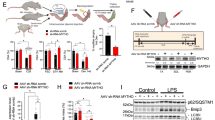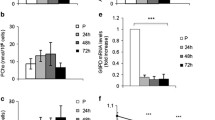Abstract
MTMR14 is a phosphoinositide phosphatase, which has been reported to regulate the maintenance of normal muscle performance and aging in mice. However, the function of MTMR14 in mouse embryonic fibroblasts (MEFs) remains largely unknown. In this study, we established MTMR14 WT and KO MEFs and showed that MTMR14 is localized in whole MEFs, with higher level in nucleus and lower in cytoplasm, partially overlapping with mitochondrial. Compared with the WT control, MTMR14 KO MEFs exhibit a higher proliferation rate and more obvious autophagy. Furthermore, we demonstrate that KO of MTMR14 significantly decreased the mRNA levels of p21 and p27, while increased those of cyclinD and cyclinE. Upon (insulin-like growth factor) IGF stimulation, we also found KO of MTMR14 enhanced the phosphorylation levels of AKT and ERK in MEFs. Based on these findings, we propose that defect of MTMR14 promotes autophagy and cell proliferation in MEFs.





Similar content being viewed by others
References
Amoasii L, Hnia K, Laporte J (2012) Myotubularin phosphoinositide phosphatases in human diseases. Curr Top Microbiol Immunol 362:209–233
Tosch V, Rohde HM, Tronchere H, Zanoteli E, Monroy N, Kretz C, Dondaine N, Payrastre B, Mandel JL, Laporte J (2006) A novel PtdIns3P and PtdIns(3,5)P2 phosphatase with an inactivating variant in centronuclear myopathy. Hum Mol Genet 15:3098–3106
Shen J, Yu WM, Brotto M, Scherman JA, Guo C, Stoddard C, Nosek TM, Valdivia HH, Qu CK (2009) Deficiency of MIP/MTMR14 phosphatase induces a muscle disorder by disrupting Ca(2+) homeostasis. Nat Cell Biol 11:769–776
Powers SK, Reid MB (2010) MIP/MTMR14 and muscle aging. Aging (Albany NY) 2:538
Romero-Suarez S, Shen J, Brotto L, Hall T, Mo C, Valdivia HH, Andresen J, Wacker M, Nosek TM, Qu CK, Brotto M (2010) Muscle-specific inositide phosphatase (MIP/MTMR14) is reduced with age and its loss accelerates skeletal muscle aging process by altering calcium homeostasis. Aging (Albany NY) 2:504–513
Vergne I, Roberts E, Elmaoued RA, Tosch V, Delgado MA, Proikas-Cezanne T, Laporte J, Deretic V (2009) Control of autophagy initiation by phosphoinositide 3-phosphatase Jumpy. EMBO J 28:2244–2258
Gibbs EM, Feldman EL, Dowling JJ (2010) The role of MTMR14 in autophagy and in muscle disease. Autophagy 6:819–820
Hnia K, Kretz C, Amoasii L, Bohm J, Liu X, Messaddeq N, Qu CK, Laporte J (2012) Primary T-tubule and autophagy defects in the phosphoinositide phosphatase Jumpy/MTMR14 knockout mice muscle. Adv Biol Regul 52:98–107
Kimmelman AC (2011) The dynamic nature of autophagy in cancer. Genes Dev 25:1999–2010
Kang R, Tang D, Lotze MT, Zeh Iii HJ (2013) Autophagy is required for IL-2-mediated fibroblast growth. Exp Cell Res 319:556–565
Nikoletopoulou V, Markaki M, Palikaras K, Tavernarakis N (2013) Crosstalk between apoptosis, necrosis and autophagy. Biochim Biophys Acta 1833:3448–3459
Maiese K, Chong ZZ, Shang YC, Wang S (2012) Targeting disease through novel pathways of apoptosis and autophagy. Expert Opin Ther Targets 16:1203–1214
Lozy F, Karantza V (2012) Autophagy and cancer cell metabolism. Semin Cell Dev Biol 23:395–401
Mathew R, White E (2011) Autophagy, stress, and cancer metabolism: what doesn’t kill you makes you stronger. Cold Spring Harb Symp Quant Biol 76:389–396
Lei Y (2013) Generation and culture of mouse embryonic fibroblasts. Methods Mol Biol 1031:59–64
Moore CB, Allen IC (2013) Primary ear fibroblast derivation from mice. Methods Mol Biol 1031:65–70
Liu X, Zheng H, Qu CK (2012) Protein tyrosine phosphatase Shp2 (Ptpn11) plays an important role in maintenance of chromosome stability. Cancer Res 72:5296–5306
Wang Z, Xu J, Zhou JY, Liu Y, Wu GS (2006) Mitogen-activated protein kinase phosphatase-1 is required for cisplatin resistance. Cancer Res 66:8870–8877
Vergne I, Deretic V (2010) The role of PI3P phosphatases in the regulation of autophagy. FEBS Lett 584:1313–1318
Dall’Armi C, Devereaux KA, Di Paolo G (2013) The role of lipids in the control of autophagy. Curr Biol 23:R33–R45
Rodriguez-Enriquez S, Kai Y, Maldonado E, Currin RT, Lemasters JJ (2009) Roles of mitophagy and the mitochondrial permeability transition in remodeling of cultured rat hepatocytes. Autophagy 5:1099–1106
Duronio RJ, Xiong Y (2013) Signaling pathways that control cell proliferation. Cold Spring Harb Perspect Biol 5:a008904
Shaw A, Olivares-Chauvet P, Maya-Mendoza A, Jackson DA (2010) S-phase progression in mammalian cells: modelling the influence of nuclear organization. Chromosom Res 18:163–178
Jin J, Yuan F, Shen MQ, Feng YF, He QL (2013) Vascular endothelial growth factor regulates primate choroid-retinal endothelial cell proliferation and tube formation through PI3K/Akt and MEK/ERK dependent signaling. Mol Cell Biochem 381:267–272
Xu J (2005) Preparation, culture, and immortalization of mouse embryonic fibroblasts. Curr Protoc Mol Biol Chapter 28:Unit 28 1
Stacey DW (2003) Cyclin D1 serves as a cell cycle regulatory switch in actively proliferating cells. Curr Opin Cell Biol 15:158–163
Zhang P, Xu X, Hu X, Wang H, Fassett J, Huo Y, Chen Y, Bache RJ (2013) DDAH1 deficiency attenuates endothelial cell cycle progression and angiogenesis. PLoS ONE 8:e79444
Wang L, Wang G, Yang D, Guo X, Xu Y, Feng B, Kang J (2013) Euphol arrests breast cancer cells at the G1 phase through the modulation of cyclin D1, p21 and p27 expression. Mol Med Rep 8:1279–1285
Kaulfuss S, Burfeind P, Gaedcke J, Scharf JG (2009) Dual silencing of insulin-like growth factor-I receptor and epidermal growth factor receptor in colorectal cancer cells is associated with decreased proliferation and enhanced apoptosis. Mol Cancer Ther 8:821–833
Haase I, Evans R, Pofahl R, Watt FM (2003) Regulation of keratinocyte shape, migration and wound epithelialization by IGF-1- and EGF-dependent signalling pathways. J Cell Sci 116:3227–3238
Fleming JM, Desury G, Polanco TA, Cohick WS (2006) Insulin growth factor-I and epidermal growth factor receptors recruit distinct upstream signaling molecules to enhance AKT activation in mammary epithelial cells. Endocrinology 147:6027–6035
Acknowledgments
This project was supported by Technology Foundation for Selected Overseas Chinese Scholar, Ministry of Personnel of China, and the Fund for Distinguished Young Scholars of Heibei Province to Jinhua Shen (Grant No. 2012FFA028).
Conflict of interest
None.
Author information
Authors and Affiliations
Corresponding author
Additional information
Jing Liu, Yin Lv, These authors contributes equally to this work.
Rights and permissions
About this article
Cite this article
Liu, J., Lv, Y., Liu, Qh. et al. Deficiency of MTMR14 promotes autophagy and proliferation of mouse embryonic fibroblasts. Mol Cell Biochem 392, 31–37 (2014). https://doi.org/10.1007/s11010-014-2015-5
Received:
Accepted:
Published:
Issue Date:
DOI: https://doi.org/10.1007/s11010-014-2015-5




